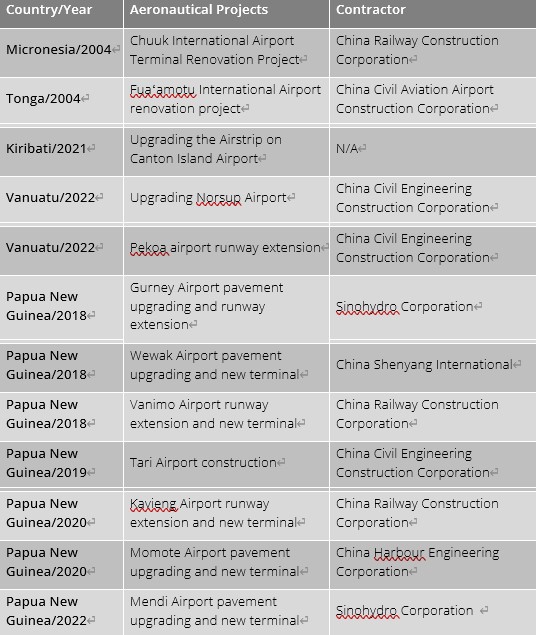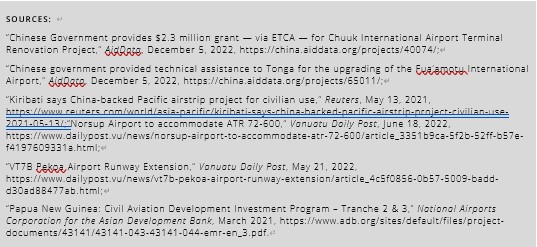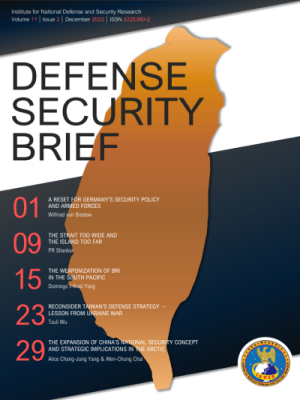THE WEAPONIZATION OF BRI IN THE SOUTH PACIFIC
2022.12.22
Views
953
INTRODUCTION
This paper investigates China’s behaviors of weaponizing the “Belt and Road Initiative” (BRI) in the South Pacific Region. Since the launch of BRI in 2013, a plethora of literature tends to highlight the contested economic aspect of BRI, rendering limited discussion on the security dimension.[1] It corresponds to the fact that China has also been deliberately framing the BRI as an economic initiative, rather than a strategic framework.[2] Xi Jinping has insisted that BRI is merely about economic cooperation and development without any military objectives. [3]
However, with respect to the military base establishment in Djibouti, China manifests its ambition to expand overseas capabilities of military, logistic, reconnoitering operations via development projects. The recent signing of the security agreement between China and Solomon Is-lands in April of 2022 has proven that the ‘String of Pearls’ theory proposed by Booz Allen Hamilton in 2005, forecasting China’s ambition to establish military facilities across the Indo-Pacific region is more than speculation.[4] China’s attempt to increase its strategic footprints in the Indo-Pacific region is a reality. In light of this context, this paper attempts to investigate the security dimension of the BRI in South Pacific by exploring China’s tendency and means to weaponize BRI projects as instruments of its security interest expansion.
THE WEAPONIZATION OF BRI
Weaponizing the BRI is embedded within China’s security-development nexus, aiming to take advantage of infrastructure deficit among developing countries and to expand China’s strategic interests via development projects. The diversified roles of PLA and civil-military fusion practices further enhance the making of an ecosystem filled with Chinese built infrastructures, strategic technologies, software, and hardware that would disadvantage the U.S. and likeminded partners’ interests militarily and economically. [5]
DEVELOPMENT IS A VEHICLE OF CHINESE SECURITY INTEREST EXPANSION
The development-security nexus defines the framework of China’s overseas developments. [6] It derives from the belief that economic deprivation causes insecurity and mirrors China’s domestic experience that political stability and security are inextricably linked with economic development success.[7] When China is expanding its footprints, ‘development’ is upheld as a solution for common security and stability, as if China’s outward engagement concentrates only on development, not the expansion of security interests.
However, given that many of China’s BRI development projects have been distributed in the most unstable areas, when China is promoting overseas development projects, its strategic sphere has been simultaneously extended. In order to make development work as a solution for common security, China has to extend its strategic influence first, creating a favorable environment for both development and China’s security interests. In this context, development is a vehicle for China to expand its own strategic interests.
THE DIVERSIFIED ROLE OF THE PLA
PLA’s ‘New Historic Mission’ introduced by Hu Jintao in 2004 manifests the tendency that China’s overseas development projects have long been weaponized via the extension of PLA’s diversified overseas activities. [8] Although the motive is to protect China’s growing overseas interests, it is also a fact that the PLA has increased its activities along with China’s overseas development projects. Military operations other than war (MOOTW) has been an essential component of PLA’s overseas behaviors since then, even international assistance such as medical aid would be counted as a routine mission of the PLA. [9]
PLA’s diversified tasks have been further intertwined with China’s overseas development projects in Xi Jinping’s era. According to “the Diversified Employment of China’s Armed Forces” issued in 2013, PLA aims to strengthen overseas operational capabilities for the protection of economic development projects, overseas energy and resources, strategic sea lines of communication (SLOCs), etc.[10] PLA’s deployment (including submarines) to the Gulf of Aden, participation of the peacekeeping operations, and non-combatant evacuation operations are examples of the larger role of PLA implemented along with China’s overseas projects. [11]
INCORPORATING DEFENSE ENTERPRISES WITH BRI VIA CIVIL-MILITARY FUSION
China’s civil-military fusion policy blends the PLA-related defense enterprises with BRI projects. Civil-military integration was one of the key pillars to the military reform agenda in 2015. [12] Under this guidance, China’s military and civilian resources can be compatible, complementary, and mutually applicable. For instance, while China’s Beidou System (BDS) provides civilian applications, the major contractors of Beidou System, such as ComNav Technology and NORINCO International are China’s state-owned defense enterprises, serving China’s military capability.
China’s ‘Law of the People’s Republic of China on National Defense Transportation’ is another example of blending military application with civilian projects.[13] Pursuant to this law, Chinese-made civilian infrastructure projects including railways, roads, waterways, and aviation could be transformed into military installations. In light of the civil-military fusion mindset, BRI’s infrastructure projects might not be excluded from this mandate and also carry a dual function serving both the local civilians and the PLA’s strategic planning.
WEAPONIZING THE BRI IN SOUTH PACIFIC
STRATEGIC INTERESTS OUTWEIGH ECONOMIC INTERESTS
China’s BRI projects toward South Pacific are not aiming at economic benefits, but strategic interests. Comparatively speaking, South Pacific, the most aid-dependent region in the world, provides less incentives for China to promote economic and commercial investments. According to statistics, the top regions receiving the most Chinese investments from 2005 to 2022 are Europe, East Asia, West Asia, Sub-Saharan Africa, Middle East and North Africa and South America.[14] Given the inadequate volume of China-South Pacific investment, the South Pacific region is excluded from the list. If we look up ‘China Global Investment Tracker,’ Australia, Papua New Guinea and Solomon Islands are the only South Pacific countries on the list.[15] Australia has received US$ 103 billion of Chinese investment from 2005 to 2022, followed by Papua New Guinea (receiving US$ 2 billion) and Solomon Islands (receiving US$ 200 million).[16] With Australia as an exception, it is clear that China’s BRI projects toward the Pacific region are not aiming for economic interests. Since many of South Pacific islands are important for geostrategic implication, it is logical to consider that China’s BRI in the South Pacific aims at strategic interests.
MILITARY AID LEADS THE WAY
In contrast to the inactive economic activities, China’s military aid toward South Pacific seems to play a more paramount role. Papua New Guinea is the largest recipient of China’s military aid in the region, amounted US$18 million between 2000 and 2020, followed by Fiji, Tonga, and Vanuatu.[17] In addition to the identified value of military aid, there are untraceable aids covering the provision of military vehicles, technologies, and personnel training.
China’s military aid to the Pacific also penetrates the public safety and law enforcement sector. For instance, China’s Ministry of Public Security signed a Memorandum of Understanding (MOU) with Fiji on April 18, 2011 to strengthen bilateral police and public security cooperation.[18] According to this MOU, China will train Fiji’s police force and provide policing technologies. Vanuatu’s mobile force has received China’s military vehicles, equipment, and funding as well. [19] From uniforms to vehicles, and to personnel training, China’s influence has infiltrated the civil society of the Pacific islands.
ESTABLISHING AERONAUTICAL PIVOTS
China is using the BRI development projects to establish aeronautical pivots among the South Pacific countries. The author has found 12 Chinese financed and constructed aeronautical projects in Micronesia, Tonga, Kiribati, Vanuatu, and Papua New Guinea (Table 1). This is an unusual proportion given that China’s economic investment toward these islands is limited. Furthermore, China’s state-owned enterprises are not only extending the airstrips, but also reconstructing the entire airports and terminal buildings with Chinese technologies and systems. Those devices would enhance China’s intelligence, surveillance, and reconnaissance in the region.
More importantly, the chief contractor of China’s aeronautical projects in South Pacific is China Railway Construction Corporation (CRCC), a PLA related state-owned corporation. China Civil Engineering Construction Corporation is a subsidy of CRCC. China Harbour Engineering Corporation is owned by China Communications Construction Company, which is also related to the PLA and sanctioned by the U.S. [20] Since these projects are constructed by large Chinese defense enterprises, it is very likely for China to use these infrastructures as aeronautical pivots in the South Pacific to improve military capabilities. For instance, the Canton Island Airport is located in the middle of Asia and America, about 1,864 miles to Hawaii. If China can further install civil-military facilities on Canton Island, it would pose a direct threat to the US.
TABLE 1: China’s Aeronautical Projects in the South Pacific


THE SECRETIVE ATTEMPT OF LEASING A PACIFIC ISLAND
China’s weaponization of BRI in the South Pacific also comes with a secretive attempt of signing a development deal with the local provincial government to lease a Pacific Island for more than seven decades. It is revealed that a state-owned China Sam Enterprise Group had signed an agreement with Solomon Islands’ Malaita province government on September 22, 2019 for a 75-year lease of the island of Tulagi.[21] Though this deal was vetoed by the Solomon Islands government, Chinese companies are still continuing to look for investment opportunities on Tulagi. [22]
The island of Tulagi is geographically significant. It was the capital of the British Solomon Islands Protectorate between 1897 and 1942.[23] Japan captured Tulagi during the Pacific War and took advantage of its natural deep water harbor for logistic support and naval base settlement.[24] The first U.S. amphibious operation during WWII took place in Tulagi and wrested control of the island from the Japanese.[25] With such strategic significance, China’s development planning toward Tulagi is expected to be compatible with strategic deployment.
China Sam Enterprise Group is a Chinese state-owned defense enterprise that has close ties with the PLA.[26] Its activities range from oil and gas exploration to the production of chemical products for national defense, the export of arms and weapons and logistic network development. China Sam Enterprise Group’s development projects are perfect vehicles serving dual-use purposes of commerce and PLA’s strategic interests. Despite the fact that the lease of Tulagi was a failed attempt, such behavior exposes China’s ambition to use development projects as an instrument to extend China’s strategic outposts in the South Pacific region.
CONCLUSION
This manuscript provides a preliminary exploration on the weaponization of China’s BRI in the South Pacific region. There are three features mapping out the weaponization of BRI. First, China is using the outward overseas development projects as a vehicle to expand its strategic and security interests. Second, the PLA’s operation has been highly diversified and actively engaged with China’s overseas development projects. Thirdly, China’s civil-military fusion policy is making most of the civilian projects containing a dual purpose of serving both civilian and military applications.
The author also finds four traits proving that the BRI has been weaponized as an instrument to enhance China’s strategic interests. First, China has not taken the South Pacific region seriously for economic development. It is the geostrategic importance that draws the BRI’s projects. Second, in contrast to the inactive economic relation, China’s military aid toward South Pacific Island countries seems to be leading the way. Third, the author has found 12 Chinese financed and constructed aeronautical projects in Micronesia, Tonga, Kiribati, Vanuatu, and Papua New Guinea functioning as aeronautical pivots to enhance China’s strategic advantages. Lastly, the case of Tulagi leasing indicates that China has the tendency to secretly take over a Pacific Island as a foothold or outpost in the Pacific Ocean.
Domingo I-Kwei Yang is an Assistant Research Fellow at the Institute for National Defense and Security Research and an Adjunct Assistant Professor of the Department of Diplomacy, National Chengchi University. His research interests cover China and the Global South, ICTs and Geopolitics and China’s Foreign Aid.
[1]Karen P. Y. Lai, Shaun Lin & James D. Sidaway, “Financing the Belt and Road Initiative (BRI): research agendas beyond the “debt-trap” discourse,” Eurasian Geography and Economics, Vol.61 No.2 (2022), pp. 109-124; Peter Harrell, Elizabeth Rosenberg and Edoardo Saravalle, China’s Use of Coercive Economic Measures, Center for a New American Security, 2022, https://s3.us-east-1.amazonaws.com/files.cnas.org/documents/China_Use_FINAL-1.pdf.
[2]Oriana Skylar Mastro, “The Stealth Superpower,” Foreign Affairs, January 2019, https://www.foreignaffairs.com/articles/china/china-plan-rule-asia; Elizabeth Economy, “China’s New Revolution,” Foreign Affairs, May 2018, https://www.foreignaffairs.com/articles/china/2018-04-17/chinas-new-revolution.
[3]Daniel R. Russel and Blake H. Berger, “Weaponizing the Belt and Road Initiative,” Asia Society Policy Institute, September 2020, https://asiasociety.org/sites/default/files/2020-09/Weaponizing%20the%20Belt%20and%20Road%20Initiative_0.pdf.
[4]“Assessing the Solomon Islands’ new security agreement with China,” IISS, May 5, 2022, https://www.iiss.org/blogs/analysis/2022/05/china-solomon-islands; Benjamin David Baker, “Where Is the ‘String of Pearls’ in 2015?” The Diplomat, October 05, 2015, https://thediplomat.com/2015/10/where-is-the-string-of-pearls-in-2015/.
[5]Daniel R. Russel and Blake H. Berger’s “Weaponizing the Belt and Road Initiative,” The Asia Society Policy Institute, 2020, https://asiasociety.org/policy-institute/weaponizing-belt-and-road-initiative.
[6]Bertha Z. Osei-Hwedie and Napoleon Kurantin, “Security-Development Nexus: China's Policy Framework towards Africa,” Electronic Journal of Social and Strategic Studies, Vol. 1 No 1 (2020), pp. 1-19.
[7]Lina Benabdallah and Daniel Large, “China’s Development-Security in Practice: The Case of Mali,” SAIS-CARI, 2020, https://www.econstor.eu/bitstream/10419/248227/1/sais-cari-pb48.pdf.
[8]James Mulvenon, “Chairman Hu and the PLA’s New Historic Missions,” China Leadership Monitor, 2009, https://www.hoover.org/sites/default/files/uploads/documents/CLM27JM.pdf.
[9]Xu Caihou, “Statesmen’s Forum: Gen. Xu CaiHou,” CSIS, October 26, 2009, https://csis-website-prod.s3.amazonaws.com/s3fs-public/event/091026csis_genxu_0.pdf.
[10] “The Diversified Employment of China’s Armed Forces,” Information Office of the State Council, 2013, http://english.www.gov.cn/archive/white_paper/2014/08/23/content_281474982986506.htm.
[11]James Siebens and Ryan Lucas, “Military Operations Other Than War in China’s Foreign Policy,” Stimson, September 2022, https://www.stimson.org/wp-content/uploads/2022/09/China-Military-Ops-Report.pdf.
[12] Brian Lafferty, “Civil-Military Integration and PLA Reforms,” in Chairman Xi Remakes the PLA: Assessing Chinese Military Reforms (Washington, D.C.: National Defense University Press, 2019), pp. 627–666.
[13]National People’s Congress, “Zhong Hua Ren Min Gong He Guo Guo Fang Jiao Tong Fa [National Defense Traffic Law of the People's Republic of China],” National People’s Congress, September 3, 2016, http://www.npc.gov.cn/zgrdw/npc/xinwen/2016-09/03/content_1996764.htm.
[14]“Total Chinese investments between 2005 and mid-2022, by global region,” Statista, October 7, 2022, https://www.statista.com/statistics/276607/chinese-investments-by-global-region/.
[15] “China Global Investment Tracker,” AEI, 2022, https://www.aei.org/china-global-investment-tracker/.
[16] Ibid.
[17]Xiao Liang, “What can we learn from China’s military aid to the Pacific?” SIPRI, June 20, 2022, https://www.sipri.org/commentary/blog/2022/chinas-military-aid-pacific.
[18] “China and Fiji cooperate on police training in 2011,” Aiddata, 2022, https://china.aiddata.org/projects/64694/.
[19] “China equipped Vanuatu Mobile Force,” Republic of Vanuatu, March 28, 2017, https://pmo.gov.vu/index.php/en/public-information/116-china-equipped-vanuatu-mobile-force.
[20] “US sanctions over South China Sea will not affect blacklisted Chinese construction giant CCCC, company says,” South China Morning Post, August 30, 2020, https://www.scmp.com/economy/china-economy/article/3099526/us-sanctions-over-south-china-sea-will-not-affect-blacklisted.
[21] “Solomon government says Chinese company's lease of island unlawful,” Reuters, October 25, 2019, https://www.reuters.com/article/uk-china-solomonislands-idUKKBN1X400C.
[22]“Solomon Islands Officials: Chinese Companies Still See Opportunity in Tulagi,” VOA, September 5, 2022, https://www.voanews.com/a/solomon-islands-officials-chinese-companies-still-see-opportunity-in-tulagi/6729558.html.
[23]“Tulagi,” OAPEN, 2022, https://library.oapen.org/handle/20.500.12657/24375.
[24]“Building the Navy's Bases in World War II,” HyperWar Foundation, 2022, https://www.ibiblio.org/hyperwar/USN/Building_Bases/index.html#contents2.
[25] “First Hell in the Pacific: The Battle for Tulagi,” Warfare History Network, 2013, https://warfarehistorynetwork.com/article/first-hell-in-the-pacific-the-battle-for-tulagi/.
[26]“China Sam Enterprise Group,” RWR, January 17, 2020, https://www.rwradvisory.com/rwr-risk-profile-china-sam-enterprise-group/.


